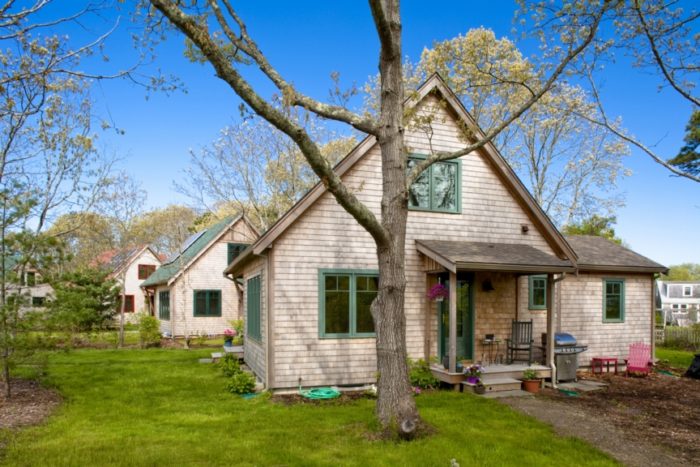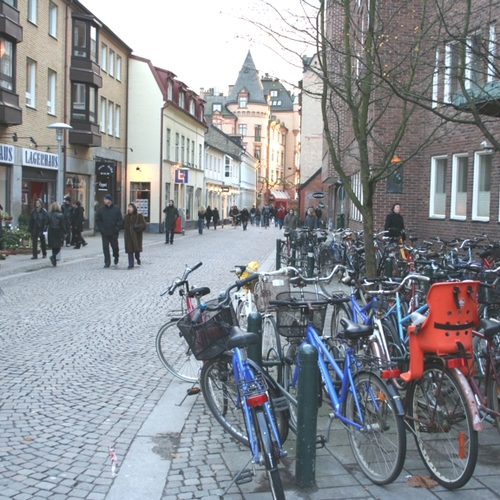Image Credit: Randi Baird
Image Credit: Randi Baird Interior of one of the Jenny Way homes, which provide a spacious feel despite the compact design.
Image Credit: Randi Baird Solar panels on the Jenny Way homes provide a significant portion of the annual electricity needs.
While the trend has begun to turn around, we’ve been building larger and larger houses for decades. In 1950, the average house in the U.S. was about 1,100 square feet, while there were about 3.4 people per household, according to data I compiled for a 1999 article in Environmental Building News. The U.S. Census Bureau reports that in 2009 the average new house in the U.S. was 2,438 square feet (down slightly from 2,518 square feet in 2008), while the average household size was 2.6 people. In the past sixty years, house size has increased 120%, while family size has dropped 24%, so square footage per family member has nearly tripled (from 324 to 938 square feet).
From an environmental and energy standpoint, building smaller houses is a winner. Smaller houses take less material to build and they use less energy to heat and cool. This is common sense, but it’s amazing how rarely people think about it.
For the same EBN article referenced above (“Small is Beautiful: House Size, Resource Use, and the Environment“), we ran some numbers comparing the annual energy use of two homes in Boston: a reasonably well-insulated, 3,000 square-foot house (R-19 walls, R-30 ceilings, double-glazed low-e windows); and a poorly insulated, 1,500 square-foot house (R-13 walls, R-19 ceilings, double-glazed non-low-e windows). Based on energy modeling by Andy Shapiro of Energy Balance, Inc., heating and cooling costs for the poorly insulated, compact house totaled $421 per year, while heating and cooling the reasonably well-insulated, large house totaled $635.
The larger house is more energy-efficient (it might even meet the standards for green home certification), but its total energy use is 50% greater than that of the smaller house. This isn’t meant to suggest that we shouldn’t insulate our houses well if they’re small, but rather to illustrate just how significant size is to the energy consumption of a house.
Very significantly, the smaller house will also likely cost less to build—even if higher quality, more expensive materials are used. When I hear that green homes cost more than standard homes, my first response is always to point out that smaller homes are much greener—and those homes usually cost less, not more.
Be aware that creating successful compact houses isn’t only a matter of shrinking the dimensions. Designing small homes that feel spacious and are comfortable requires a skilled architect or designer. Expect to spend more for a design that minimizes square footage yet feels spacious and comfortable. The investment in design will be paid back during construction–and lower operating costs.
Optimizing the use of materials
In addition to building smaller, there are other ways we can save materials—and money—in building. A few of these strategies are listed below:
- Use standard ceiling heights. Materials cost and cut-off waste can be reduced by building to the standard dimensions of studs and drywall.
- Build on a standard two-foot or four-foot module size. House dimensions of 28 feet by 36 feet for example, will use about the same quantity of materials as a house that’s 26-1/2 feet by 34-1/2 feet, because lumber and sheet goods come in multiples of two or four feet.
- Use “advanced framing” techniques with wall and roof framing 24 inches on-center, single top-plates with rafters set exactly above studs, wall corners produced with three rather than four studs, and the elimination of unneeded framing at window and door openings. Not only will advanced framing techniques save materials, they will also improve energy performance, because there’s less wood and wood doesn’t insulate as well as insulation.
Both of these strategies—building smaller and optimizing materials use—save money during construction and reduce energy consumption. It’s a win-win solution that’s become all the more important in our highly constrained economy.
My top-10 list of green building priorities so far:
#5. Build smaller and optimize materials use
#6. Ensure durability and reuse existing buildings
#7. Protect and restore the site
#9. Create resilient, climate-adapted buildings
#10. Make it easy for homeowners to be green
In addition to this Energy Solutions blog, Alex writes the weekly blog on BuildingGreen.com, Alex’s Cool Product of the Week, which profiles an interesting new green building product each week. You can sign up to receive notices of these blogs by e-mail—enter your e-mail address in the upper right corner of any BuildingGreen.com blog page.
Alex is founder of BuildingGreen, LLC and executive editor of Environmental Building News. To keep up with his latest articles and musings, you can sign up for his Twitter feed.
Weekly Newsletter
Get building science and energy efficiency advice, plus special offers, in your inbox.
















7 Comments
A Challenge for Architects
Let the masters of space and light now design smaller, better performing, more spacious homes using only full sizes of sheet materials and a two-foot module.
Response to PHastings
PHastings,
Where do you buy your sheet materials?
I think you meant to write "four-foot module."
Two-foot module
Hey Martin,
I often suggest a two- or four-foot module for building dimensions. I don't think there's much more waste with a 30' wall than a 28' or 32' wall. Eight-, ten-, and 12-foot lengths are readily available for certain sheet goods. So I'm standing with PHastings. :-)
Back to the Future
PHastings - Talking about this sort of thing used to make client's eyes glaze over, but clients have begun asking for smaller homes again, and for the ones who don't ask, they're much easier to persuade of the benefits. Better design always results in a better living experience, a more efficient home, lower cost to build and operate, less waste...and more fun to design!
http://www.rtastudio.blogspot.com
Bravo
RLTarch seems to be at least one architectural practitioner who has not only seen the sense of building as described but also appears to relish the challenge.
Glazing eyes
My eyes glaze over when listening to a potential client go on about how they are expecting their first child and live in a 2000 square foot house and how are they going to fit their new child? and they need an addition or a whole new house. etc etc.
Actually, I often run into the client's bank requiring that if they are building a three bedroom house for instance, that it has to be a certain minimum square footage. Or at least that's what the client tells me.
http://www.swinburnearchitect.com
average house size
what is the average house size as opposed to the average new house size in the united states? I have been unable to find this number.
http://www.swinburnearchitect.com
Log in or create an account to post a comment.
Sign up Log in